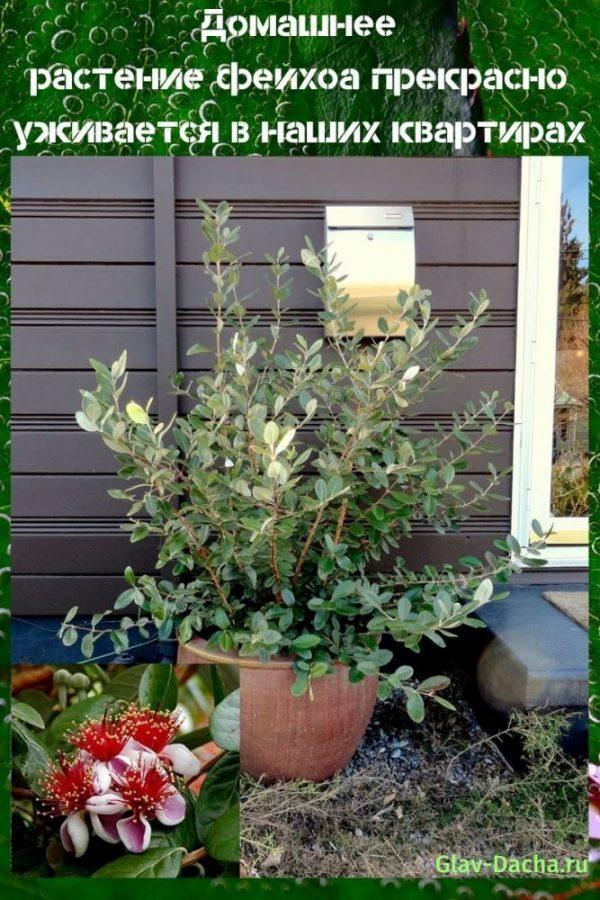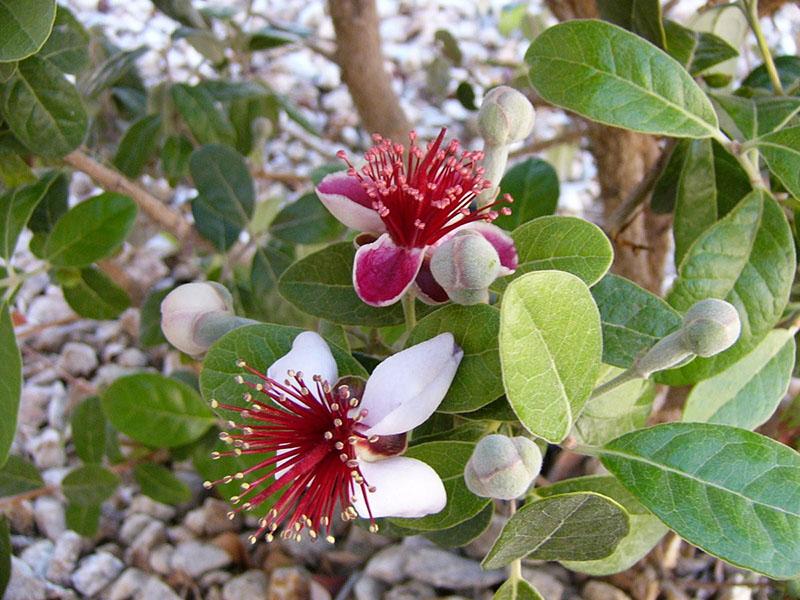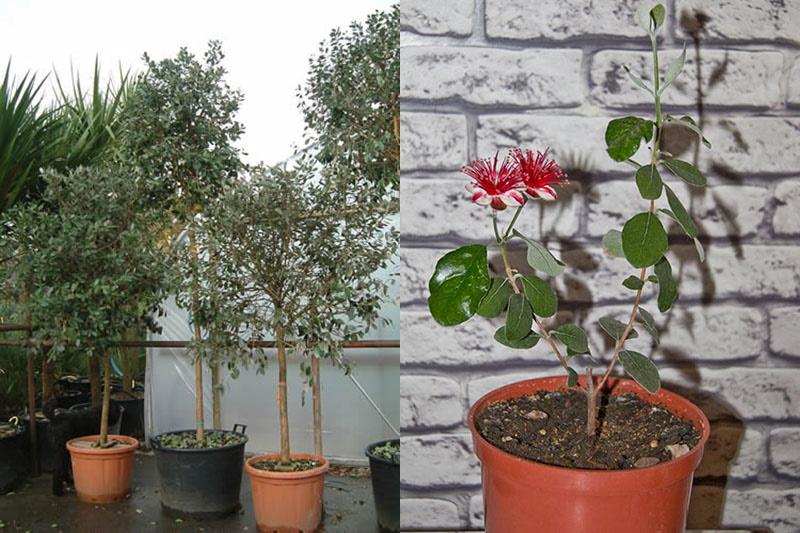The feijoa houseplant gets along well in our apartments
 A subtropical shrub (tree) from the Myrtle family is distinguished by its special decorativeness not only in the wild, but also in the indoor interior. The feijoa house plant has a luxurious bloom that combines many stamens and shell-like petals. Moreover, in favorable conditions, the exotic plant bears fruit with miniature fruits with the taste of kiwi, strawberry and pineapple. The berries of this culture are very useful because they contain a high percentage of iodine, silicon and vitamin C. Therefore, growing feijoa at home will be a significant contribution to the health of the family, as well as to the interior of the house.
A subtropical shrub (tree) from the Myrtle family is distinguished by its special decorativeness not only in the wild, but also in the indoor interior. The feijoa house plant has a luxurious bloom that combines many stamens and shell-like petals. Moreover, in favorable conditions, the exotic plant bears fruit with miniature fruits with the taste of kiwi, strawberry and pineapple. The berries of this culture are very useful because they contain a high percentage of iodine, silicon and vitamin C. Therefore, growing feijoa at home will be a significant contribution to the health of the family, as well as to the interior of the house. 
Home plant feijoa native to Brazil
 In the subtropical latitudes of South America, the wild plant is found both as a shrub and as a tree. Usually the crown of the exotic is quite spreading. In some cases, it reaches 4-6 m in height. The root system, although compact, is unusually dense and branched. To a greater extent, the rhizome is located in the upper layers of the soil cover. Cultivated specimens are tree-like shrubs, which often form into trunks, with a dense spreading crown.
In the subtropical latitudes of South America, the wild plant is found both as a shrub and as a tree. Usually the crown of the exotic is quite spreading. In some cases, it reaches 4-6 m in height. The root system, although compact, is unusually dense and branched. To a greater extent, the rhizome is located in the upper layers of the soil cover. Cultivated specimens are tree-like shrubs, which often form into trunks, with a dense spreading crown.
The characteristic features of the feijoa house plant are:
- thin shoots with rough light brown bark;
- leathery oval leaves with a glossy sheen and silvery pubescence on the back of the plate;
- spectacular flowers: burgundy high stamens (50-80 pcs.) and soft pink petals wrapped inward.

The tropical culture is appreciated by flower growers for its decorative effect, in particular for its extraordinary flowering.
Flowers often form into thyroid inflorescences. The budding period begins in June (end of May) and lasts for 20-30 days. Nevertheless, pollinating insects are necessary for the formation of ovaries.  When the fruits ripen, they become dark green in color with small tubercles on the surface, as well as a slight bluish bloom. The berries reach 20-70 mm in length, and 15-50 mm in cross-section. They usually weigh from 30 to 50 g each. Inside, oval-elongated fruits have special chambers that contain a jelly-like pulp with seeds. The taste of the fruit is quite specific. A combination of pineapple and strawberries with a light kiwi flavor reminds many of them.
When the fruits ripen, they become dark green in color with small tubercles on the surface, as well as a slight bluish bloom. The berries reach 20-70 mm in length, and 15-50 mm in cross-section. They usually weigh from 30 to 50 g each. Inside, oval-elongated fruits have special chambers that contain a jelly-like pulp with seeds. The taste of the fruit is quite specific. A combination of pineapple and strawberries with a light kiwi flavor reminds many of them.
In order for akka to bear fruit in an apartment, it is recommended to choose self-pollinating varieties: Early Crimean, Pervenets, and Nikitsky (fragrant).
From the eaten berries we get planting material
 The answer to the question of how to grow a feijoa at home is to consider the main methods of culture propagation. The simplest and most accessible to many is seed. However, the main feature of this technique is the use of only fresh seed. Otherwise, there will be no shoots.
The answer to the question of how to grow a feijoa at home is to consider the main methods of culture propagation. The simplest and most accessible to many is seed. However, the main feature of this technique is the use of only fresh seed. Otherwise, there will be no shoots.
So, the breeding technology includes several stages:
- the seeds are removed with a spoon from a ripe, but not overripe, fruit;
- then disinfected in a weak solution of potassium permanganate (15-30 minutes);
- sent to a dark place for drying (3-5 days);
- prepare the substrate by mixing deciduous soil and peat (2 hours each), as well as coarse sand (1 hour);
- seeds are sown on the surface of the soil mixture, slightly crushing with earth;
- moisten with a spray bottle;
- cover with glass / film;
- sent to a well-lit and warm room (+ 23 ... + 25˚C).
The best time for planting is February or March. In some cases, the event is held in May-June.
As the soil dries out, the planting is watered. The container is opened daily for ventilation (up to 15 minutes). After the first shoots appear, the shelter is removed.
Seedlings dive in the phase of 3-4 true leaves, planting in separate pots with more fertile soil:
- turf land (3 or 6 parts);
- deciduous humus (2-4 hours);
- rotted manure (0.5-1 hours);
- coarse sand (0.5-1 hours).
The prepared substrate is disinfected with a special solution or using high temperatures (in the oven). At the bottom of the pot, a drainage layer must be laid using expanded clay or pebbles. Thanks to such a transplant, the root system develops much faster. As a result, the seedlings grow rapidly. Nevertheless, the formation of fruits on such specimens occurs only 5-6 years after planting. Now it's time to find out how feijoa grows at home. The basic agrotechnical rules for growing exotic plants will help provide the shrub with a suitable microclimate and achieve excellent results in this matter.
Thanks to such a transplant, the root system develops much faster. As a result, the seedlings grow rapidly. Nevertheless, the formation of fruits on such specimens occurs only 5-6 years after planting. Now it's time to find out how feijoa grows at home. The basic agrotechnical rules for growing exotic plants will help provide the shrub with a suitable microclimate and achieve excellent results in this matter.
Create real tropics for an exotic plant
 Taking into account the natural habitat of the culture and its characteristic features, it can be concluded that akka needs sun, warmth, humidity and space. It is not difficult to create a similar atmosphere for a tropical "guest" in a Russian apartment. You just need to understand how to care for feijoa in each case.
Taking into account the natural habitat of the culture and its characteristic features, it can be concluded that akka needs sun, warmth, humidity and space. It is not difficult to create a similar atmosphere for a tropical "guest" in a Russian apartment. You just need to understand how to care for feijoa in each case.
Location
 Bright lighting is the most favorable option for exotic, because leathery foliage rarely suffers from exposure to direct sunlight. As for the winter period, it is often recommended for a flowerpot to install phytolamps at a height of 25 cm from the crown. Many growers place crops on the east or south-east side of the apartment. Such conditions for keeping feijoa can be as close to natural as possible.
Bright lighting is the most favorable option for exotic, because leathery foliage rarely suffers from exposure to direct sunlight. As for the winter period, it is often recommended for a flowerpot to install phytolamps at a height of 25 cm from the crown. Many growers place crops on the east or south-east side of the apartment. Such conditions for keeping feijoa can be as close to natural as possible.
Still, for young shoots, more diffused lighting is required.
Temperature and humidity
 Brazil's subtropical latitudes have a very hot and humid climate. However, this does not mean that such an environment is necessary for a houseplant. The best option in the summer for Akka will be a temperature within + 20 ... + 25˚С. So the shrub will acquire a special exotic decorative effect. In the summer, a feijoa in a pot is taken out to a balcony or street, placing the flowerpot away from drafts. In winter, the temperature regime is maintained at + 12 ... + 15˚С.
Brazil's subtropical latitudes have a very hot and humid climate. However, this does not mean that such an environment is necessary for a houseplant. The best option in the summer for Akka will be a temperature within + 20 ... + 25˚С. So the shrub will acquire a special exotic decorative effect. In the summer, a feijoa in a pot is taken out to a balcony or street, placing the flowerpot away from drafts. In winter, the temperature regime is maintained at + 12 ... + 15˚С.
 High humidity (about 80%) is the main component of the success of growing exotic plants. To do this, every day the bush is completely sprayed from the rhizome to the top with warm water. The plant especially needs such procedures in extreme heat or during the heating season.
High humidity (about 80%) is the main component of the success of growing exotic plants. To do this, every day the bush is completely sprayed from the rhizome to the top with warm water. The plant especially needs such procedures in extreme heat or during the heating season.
During dry periods, shrubs require regular warm showers. During the event, the root system is covered with foil.
Watering and feeding
 Although feijoa prefers high humidity, extreme care is needed with regard to watering. To obtain abundant flowering and fruiting, maintain a stable level of soil moisture. At the same time, both the drying of the soil substrate and its waterlogging are not allowed. In this regard, watering is carried out only when the top layer of the earth dries out. The water that collects in the pan must be drained in order to avoid root rot.
Although feijoa prefers high humidity, extreme care is needed with regard to watering. To obtain abundant flowering and fruiting, maintain a stable level of soil moisture. At the same time, both the drying of the soil substrate and its waterlogging are not allowed. In this regard, watering is carried out only when the top layer of the earth dries out. The water that collects in the pan must be drained in order to avoid root rot.
When the soil dries out, the feijoa house plant sheds its foliage. In addition, this leads to partial death of the shoots.

Indoor culture reacts positively to complex fertilizers, both mineral and organic. In the spring, Akka needs potash and nitrogen compounds, and in the summer it needs potassium-phosphorus.
Nutrient mixtures are added only during:
- active growth;
- flowering;
- fruiting.
To obtain a rich harvest, mineral preparations are replaced with organics or biofertilizers. The frequency of feeding does not exceed 2 times a month.
Pruning
 High decorative feijoa is impossible without regular crown formation. At the young plant stage, the central stem is shortened by ¼ or 1/3 of the height. Then, as it grows, pinch the side shoots. Some create a stem or a tree with a strict crown from a shrub. To do this, cut off all root growth. All sections are treated with a fungicide.
High decorative feijoa is impossible without regular crown formation. At the young plant stage, the central stem is shortened by ¼ or 1/3 of the height. Then, as it grows, pinch the side shoots. Some create a stem or a tree with a strict crown from a shrub. To do this, cut off all root growth. All sections are treated with a fungicide.
IMPORTANT! Root shoots negatively affect the fruiting of exotic plants. In this regard, root suckers are removed.
Pest and disease control
 Subject to all the rules of planting and care, the tropical culture practically does not get sick. However, improper (excessive) watering increases the likelihood of gray mold. In this case, the affected areas are cut out, capturing healthy parts, and treated with a fungicide or Bordeaux liquid. Then, an optimal irrigation system is established.
Subject to all the rules of planting and care, the tropical culture practically does not get sick. However, improper (excessive) watering increases the likelihood of gray mold. In this case, the affected areas are cut out, capturing healthy parts, and treated with a fungicide or Bordeaux liquid. Then, an optimal irrigation system is established.
 Highlighting the main diseases and pests of feijoa, it is worth mentioning the spider mite and the false shield. To combat these insects, gardeners use Keltan's solution (2 g / l). Spraying is planned for the evening hours so that burns do not appear on the foliage. Also, the Karbofos solution (5-6 g / l), which is used to pickle akk, has shown its effectiveness. The procedure is carried out 2-3 with an interval of 5-7 days. In addition, a warm shower is organized for the plant, since insects cannot tolerate a humid environment. With this care, an exotic shrub will delight its owner with abundant flowering and fruiting.
Highlighting the main diseases and pests of feijoa, it is worth mentioning the spider mite and the false shield. To combat these insects, gardeners use Keltan's solution (2 g / l). Spraying is planned for the evening hours so that burns do not appear on the foliage. Also, the Karbofos solution (5-6 g / l), which is used to pickle akk, has shown its effectiveness. The procedure is carried out 2-3 with an interval of 5-7 days. In addition, a warm shower is organized for the plant, since insects cannot tolerate a humid environment. With this care, an exotic shrub will delight its owner with abundant flowering and fruiting.